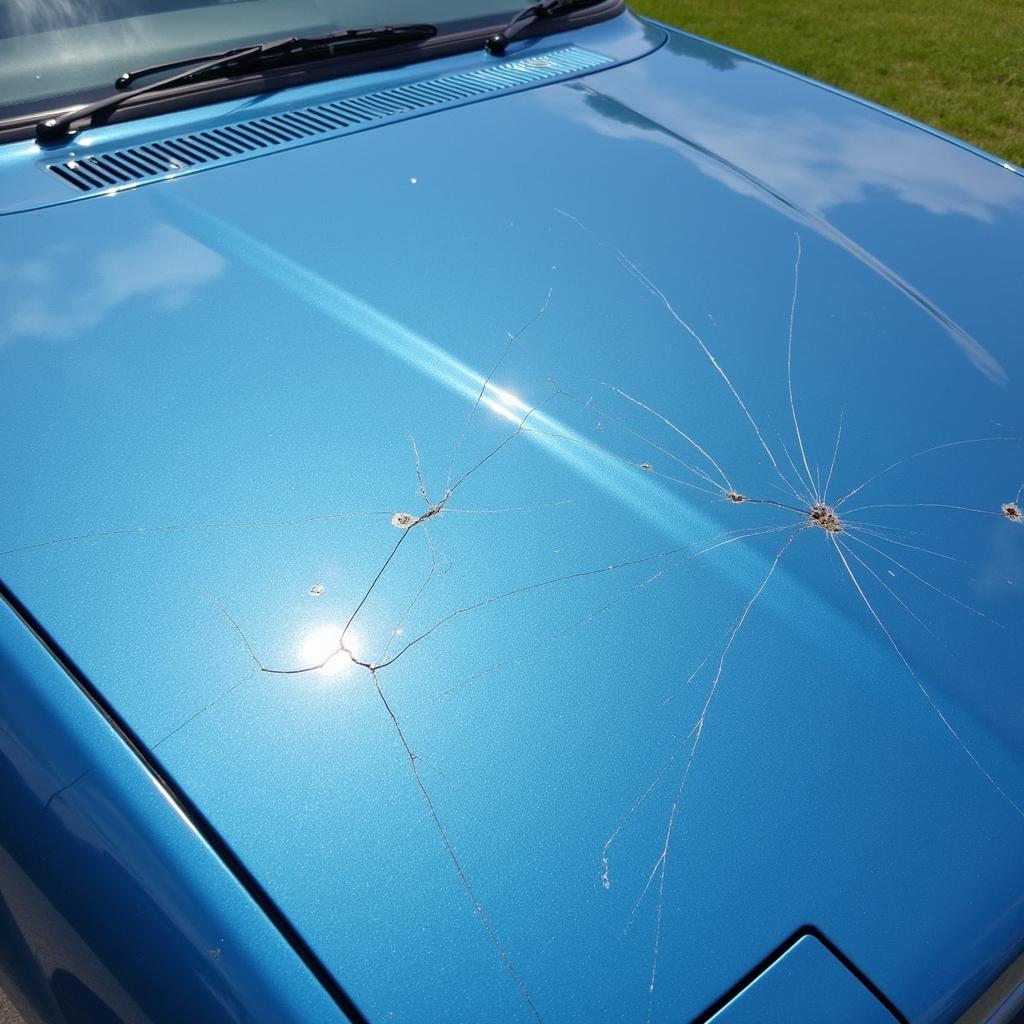One of the most disheartening discoveries for any car owner is finding cracks in their car’s paint. Not only are these cracks unsightly, but they can also lead to more serious problems like rust and corrosion if left untreated. Fortunately, repairing paint cracks on your car is often more straightforward than you might think. This comprehensive guide will delve into the causes, prevention methods, and step-by-step repair techniques for those pesky paint cracks, empowering you to restore your car’s finish to its former glory.
Understanding the Enemy: Causes of Paint Cracks on Cars
Before diving into solutions, it’s crucial to understand what causes paint cracks in the first place. Identifying the root cause can help you address the issue more effectively and prevent it from recurring.
- Sun Damage: Prolonged exposure to the sun’s harmful UV rays is a leading cause of paint damage, including cracking, fading, and clear coat peeling.
- Weather Extremes: Extreme temperature fluctuations, especially rapid changes from hot to cold, can cause the car’s metal to expand and contract, stressing the paint and leading to cracks.
- Improper Washing Techniques: Using harsh chemicals or abrasive materials when washing your car can strip away its protective layers, making it vulnerable to cracking.
- Minor Accidents and Impacts: Even seemingly minor bumps and scrapes can compromise the paint’s integrity, leading to hairline cracks that worsen over time.
- Poor Quality Paint Job: If your car was previously repainted with low-quality paint or if the application process was flawed, the paint job may be more susceptible to cracking.
Prevention is Key: Protecting Your Car’s Paint
While some causes of paint cracks are unavoidable, many can be prevented by adopting some simple preventative measures:
- Regular Washing and Waxing: Regularly washing your car with a pH-balanced car wash soap and following up with a high-quality car wax can help protect the paint from UV rays, environmental contaminants, and minor scratches.
- Parking in the Shade: Whenever possible, park your car in the shade or use a car cover to minimize its exposure to direct sunlight.
- Addressing Scratches Promptly: If your car does acquire minor scratches or chips, address them promptly with touch-up paint to prevent rust and further damage.
Repairing Paint Cracks: A Step-by-Step Guide
For minor paint cracks, you can often tackle the repair yourself using readily available products.
Materials You’ll Need:
- Automotive soap and water
- Clean microfiber cloths
- Sandpaper (220-grit, 320-grit, 1000-grit)
- Primer (if necessary)
- Touch-up paint (matching your car’s color)
- Clear coat
- Rubbing compound
- Polishing compound
Procedure:
- Clean the Area: Thoroughly wash and dry the area around the crack to remove any dirt, debris, or wax.
- Sand the Crack: Using 220-grit sandpaper, gently sand the crack and the surrounding area to create a smooth surface for the new paint to adhere to. Gradually increase the sandpaper grit (320-grit, then 1000-grit) to achieve a smooth finish.
- Prime (If Necessary): If you’ve sanded down to the bare metal or if the crack is deep, apply a thin coat of automotive primer to the area and allow it to dry completely.
- Apply Touch-Up Paint: Carefully apply thin coats of touch-up paint that matches your car’s color to the sanded area, allowing each coat to dry before applying the next.
- Apply Clear Coat: Once the touch-up paint is dry, apply a few thin coats of clear coat to seal and protect the paint.
- Buff and Polish: After the clear coat has cured (typically 24-48 hours), use a rubbing compound and a polishing compound to buff the area and blend it seamlessly with the surrounding paint.
When to Seek Professional Help
While DIY repair is suitable for minor cracks, some situations call for professional intervention:
- Large or Deep Cracks: If the cracks are extensive, deep, or accompanied by significant paint chipping or peeling, seeking professional help is recommended.
- Rust Formation: If you notice rust formation around the cracks, it’s essential to address it promptly by a professional to prevent further damage.
- Lack of Confidence: If you’re unsure about performing the repair yourself or lack the necessary tools and experience, it’s always best to leave it to the professionals.
FAQs: Repairing Paint Cracks on Cars
Q: Can I use nail polish to repair a paint crack on my car?
A: While tempting for a quick fix, using nail polish is not recommended. Nail polish is not designed for automotive paint and may not adhere properly or match the color accurately. It can also react negatively with car paint, causing further damage.
Q: How can I prevent paint cracks from reappearing?
A: Implement a regular car care routine that includes washing, waxing, and parking in the shade whenever possible. This helps protect your car’s paint from the elements and reduces the risk of cracks.
Q: Can I repair paint cracks on plastic bumpers?
A: The repair process for plastic bumpers is similar, but using a plastic primer and paint specifically designed for plastic surfaces is crucial for optimal adhesion and durability.
how to repair cracks in car paint
Seeking Professional Car Paint Repair?
For professional assistance in repairing paint cracks or addressing any other car paint issues, consider contacting CarRepairOnline. We offer expert car paint repair services at competitive prices. Our skilled technicians use high-quality products and techniques to restore your car’s finish to its pristine condition.
car paint repair gravesend
car paint repair leamington spa
Don’t let paint cracks detract from your car’s appearance and value. By understanding the causes, implementing preventative measures, and knowing when to seek professional help, you can keep your car looking its best for years to come.


